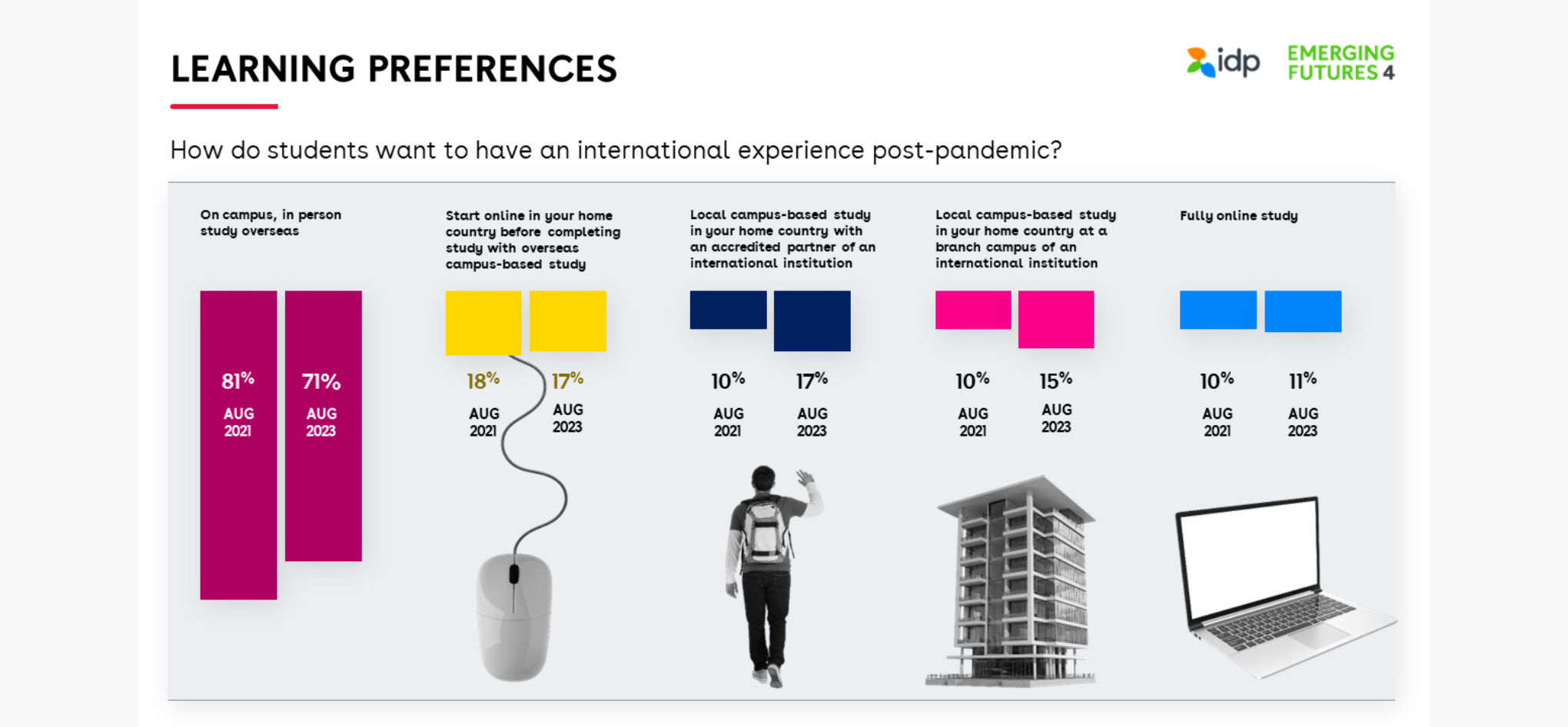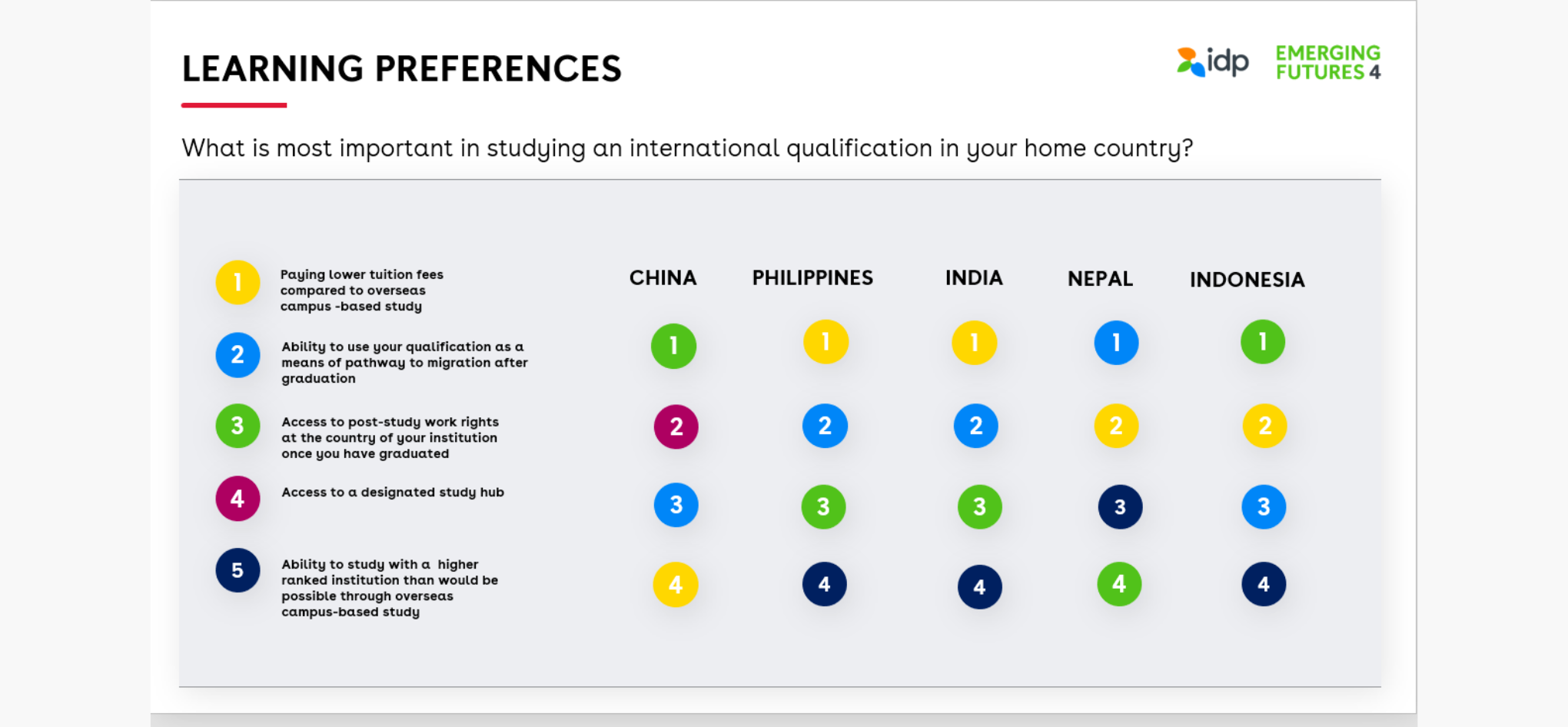The global cost of living crisis began in mid to late 2021 and the prospective students who were planning their international education 18 months ago, as prices started to rise, are now likely to be either studying abroad or getting ready to pack their bags for January and September 2024 intakes. Many students are likely to have felt the difficulties of high inflation and fluctuating foreign exchange rates and some may be struggling with several other issues relating to costs.
Our Emerging Futures 4 (EF4) survey asked students a variety of questions relating to ‘cost of living’ and in this article, we take a deep dive into what their responses tell us about how the crisis is affecting the student experience and what institutions can do to help.
Is the increasing cost of living stopping some students from studying abroad?
Our EF4 survey of more than 10,000 students (prospective, applied, current, and completed) was undertaken in August 2023.
When we asked the prospective students who had not yet applied (cohort = 3,522) whether the recent increases in cost of living had made them reassess their choice to study overseas, 63% said ‘Yes’. In our previous research, EF3 in March 2023, this figure was 55%. This indicates that financial considerations are still uppermost in many students’ minds.
Of the top-four international education destinations, students who had indicated the UK as their first-choice destination were most likely to be reconsidering (65%), followed by Canada (61%), USA (59%) and Australia (58%).
When looking at the data from source markets, of the prospective students from India who had not yet applied, 54% said they were reassessing studying overseas, while 69% of the cohort from China and 71% from the Philippines also said they were reassessing. In all top-five student cohorts in our survey, more than half of the respondents were reassessing their choice to study overseas due to the recent increases in cost of living.
When we sort the data by study level, pathway students who had not yet applied are the most likely to be reconsidering their international education plans; 71% said they are rethinking. Postgraduate level students and undergraduate level students are the least likely to be reconsidering; however, of these cohorts the proportion reassessing is still high at 61% in both groups.
Modes of learning and the international education experience
Many of us in the international higher education sector believed that when the coronavirus lockdowns and travel restrictions ended, overseas study would return to or even exceed its pre-pandemic popularity and, yes, a speedy bounce back has been evident. However, when we look at the various learning modes that students are considering, since our New Horizons research in August 2021, there has been a 10% decline in student consideration of on-campus overseas study – other modes of study are seeing increased interest.

In August 2021, 10% of the cohort said they would consider campus-based study in their home country with an accredited partner of an international institution and in August 2023, in our EF4 survey, this has risen by 7% to 17%.
Local campus-based study in the home country at a branch campus of an international institution was considered by 10% in August 2021, but consideration of this mode has risen 5% to 15% in the latest research.
These shifts in considered study modes show how international students are thinking differently about international education. As there is no longer any restriction on travel, we can surmise that this change is due to other issues. Concern about the cost of studying abroad is likely to be an important factor in preferred study modes for international students.
When we look at the source markets, prospective students from Pakistan and India had the highest respondent cohorts who were considering on-campus overseas study (86% and 85% respectively). While 40% of students from China said this was a consideration for them. Students from China and the Philippines were more likely to be considering other methods of study.
The global EF4 cohort of prospective students ranked being able to pay lower tuition fees compared with campus-based study as their top condition for studying an international qualification in their home country. However, students from China ranked this as their fourth-place condition, with ‘access to post-study work rights in the institution country’ as their top condition and ‘access to a designated study hub which offers a meeting place and free support services’ as their second-place condition.
Students from the Philippines and India ranked ‘paying lower tuition fees’ as their top condition for studying in their home country to achieve their international qualification. Followed by the ability to use the qualification as a means of pathway to migration in the study country.

Students considering local options for their international education experience are citing a mix of priorities; financial savings, post-study work rights, immigration pathways, and availability of support services are all factors that need to be met for students to consider undertaking their international education in their home country.
Institutions with transnational education (TNE) programs or international branch campuses (IBCs), should look closely at how these offerings are being promoted and evaluate what the main considerations are for the source markets they are hoping to recruit.
The international higher education sector must continue conversations with government and policy makers to ensure that students choosing to undertake TNE or IBC studies do not lose out on international education benefits and that the quality of their education is maintained. There are numerous benefits of TNE exports available for providers, but the offerings must be regulated properly and students must receive value for money relating to the factors that are important to them.
Do prospective students know how much money they will need to study abroad?
We asked prospective students and those who had applied how knowledgeable they are about the amount of money they will need for food, accommodation, and transportation, etc. while studying overseas in their chosen destination. Of the global prospective and applied student cohort 29% said they were ‘highly knowledgeable’, 57% said they had ‘some general knowledge’, and 14% said they had ‘little to no knowledge’ of the cost of living.
When we asked the same global cohort of prospective and applied students if they are confident they will have enough money to live on, 69% said ‘Yes’, 10% said ‘No’, and 21% are ‘Not sure’.

This data shows a discrepancy between prospective students’ perceived knowledge of the costs and their confidence that they will have enough money to live on. The level of students who are confident about having enough money does not match those who say they are fully aware of what it costs to study abroad.
To demonstrate this, when we asked current students to tell us about their experiences when looking for private accommodation, the responses, illustrated below, show us that a significant proportion of students are not finding it easy to secure accommodation that fits in with their budgets or expectations.

Challenges relating to global economic conditions
Many students arrive in their study destination with the understanding that they will be funded by financial contributions from family, loans, scholarships and/or bursaries; however, these funds may be affected by global economic conditions and subject to fluctuations in inflation and foreign exchange rates. In our recent Global Policy Report (exclusive to Core Partners; this can be accessed in My IDP Connect) we looked at Nigeria and the devaluation of the naira commenced by the Central Bank of Nigeria in June 2023. One student described how the GBP exchange rate had increased from around 850 naira to more than 1,000 naira per pound in the space of just two months. This student said the situation had been very challenging. An ICEF Monitor report, published in April 2023, highlighted how high inflation and/or a devalued domestic currency may be causing students from some source market countries to reconsider plans for international study. The countries the report featured include:
Egypt
Ghana
Iran
Nigeria
Turkey
Sri Lanka
The report also names Brazil, Mexico, Bangladesh, Thailand, and Vietnam as emerging markets with more stability. Many international students arrive in their study destinations recognising they will need to find part-time work to fund their studies and living costs. However, as prices rise and with restrictions on the number of hours students can work, it is not always the case that part-time work will cover all the necessary costs. This possibility needs to be addressed in recruitment messaging and pre-arrival orientation programs, so that students are fully aware of the costs.
Part-time work during study
The issue of international students doing part-time work during their studies can be a divisive subject. Some commentators suggest that students should focus their energies solely on their education to achieve the best academic outcomes and studies have shown that working too many hours can have negative consequences, even affecting student mental health. An IDP report, Supporting the Mental Health of International Students, shows that the highest percentage of the student cohort in the Emerging Futures 2 survey who were experiencing poor mental health “always” or “often” were those working less than 10 hours or more than 40 hours per fortnight (37% and 31% respectively).
The report suggests that “the incidence of poor mental health in those students working only a few hours could be linked to several factors including isolation and anxiety about finances. Whereas in the cohort working more than 40 hours a fortnight, the poor mental health episodes could be caused by stress, overtiredness, and concern about attainment in their studies”.
However, many commentators acknowledge that when international students undertake a reasonable number of hours of part-time work it can provide an invaluable layer of experience during their time overseas as it assists with language skills and enables a very different cultural experience than that which they may have on campus.
In the current economic climate, the need for extra income may well be unavoidable for most students, so we asked prospective students and those who had already applied whether they were planning to work alongside their studies. Of this cohort, 80% said ‘Yes’, 13% said they were ’Not sure’, and 7% said ‘No’ they were not planning to work alongside their studies.
Of the students who were studying when the survey took place, 63% said ‘Yes’ they are working alongside their studies, and 37% said ‘No’ they are not working. Of the top four destinations, students in Canada are the most likely to be working alongside their studies (69%), the UK was next (64%), then Australia (59%) and students in the USA were least likely to be working part time, with 50% of the students saying they are working.
Of the students who told us they are not working part time during their studies, a quarter said they were still looking for part-time work. Students in the USA were most likely to tell us that finishing their course/program on time is more important than working part time. While students in Canada were most likely to tell us that it was hard to find part-time work where they live.
We wanted to understand whether students’ perceptions of how many hours they think they will work and the reality for current students matches up.
When we asked the global cohort of prospective students (not yet applied) how many hours they intend to work per fortnight, 20% said 31 to 40 hours. However, of the current students, 25% are working 31 to 40 hours.
Of all cohorts (prospective, applied, and current students), the most common number of work hours is 10 to 20 hours per fortnight with 30% of prospective students, 35% of applied students, and 31% of current students choosing this answer.

Almost three quarters of the prospective students who had not yet applied (73%) expected that their institution would help them find part-time work while they studied abroad. While such services are unlikely to be a direct part of your institutions marketing messaging – after all, the focus should be on education excellence and great student experience – this is a strong indicator that international students will feel more confident about their prospective choice of destination if the issue of finances and cost of living are addressed early by institutions.
Preparation is key, so the information we give to students is crucial
Overall, the USA was perceived to have the highest cost of living. Students scored their perception of the cost of living out of ten, where ten is high cost of living and zero is low cost of living. The average score given by prospective students who had not yet applied was 7.8 for the USA. The UK came in just behind with an average score of 7.7, followed by Australia with 7.0 and Canada 6.9.
Interestingly, when we asked parents the same question, the top-four study destinations were given slightly higher average cost of living scores across the board, although they still ranked in the same order: USA 8.2, UK 8.0, Australia 7.2, and Canada 7.1. This shows that parents might be slightly more informed about the cost of living overseas, or perhaps that they are more concerned by high costs in these destinations.
As we’ve seen, a proportion of students are reconsidering their options when it comes to international study and your institution should tailor its messaging accordingly. Helping students, and familial decision makers, understand how affordable university life is with you and what assistance is available, should be key considerations in your marketing and overarching support messaging.
Our EF4 survey showed us that 57% of prospective students said they have “some general knowledge” of the costs involved in studying abroad, so providing clear and accessible information about the full finances required is crucial – not only to ensure that students applying and enrolling at your institution can afford to live and study with you, but also to lessen the impact on your support services departments further down the line.
Emma Skelton, Head of Client Success International (UK and Europe) at IDP Connect, says, “The ability of students to be able to afford international higher education is almost certainly being analysed more closely prior to travel right now, which is highlighted by 63% of prospective students in Emerging Futures 4 saying they are reconsidering international on-campus study. This could be a pipeline challenge for at least the next two years, especially as we see local modes of learning being considered more often.
“The challenge for institutions will be to balance successful recruitment while ensuring that students have realistic expectations about the cost of living to support a positive student experience and good outcomes.”
Our article How the Cost of Living Crisis is Uniquely Affecting International Students, takes a focused look at factors currently affecting the international education sector in Australia.
To find out more about Emerging Futures and IDP Connect’s suite of products and services, get in touch with our team: https://www.idp-connect.com/contact
You might like...

GLOBAL PRESS RELEASE: Emerging Futures, Voice of the International Student
US takes pole position in the eyes of international students whilst Australia takes second place

Indonesia: The Rising Source Market of Southeast Asia
Our latest regional source market report focusing on Indonesia as a growing diversity market

Changing Parental Perceptions and Motivations in the International Education Decision Making Process
Parents are now more concerned about graduate employment opportunities than distance from friends and family.

